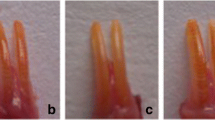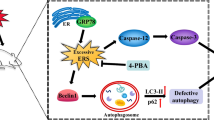Abstract
This study investigated neurotoxicity of chronic fluorosis in the rat hippocampus. Newly weaning, male, Sprague-Dawley (SD) rats were administered 15, 30, and 60 mg/L sodium fluoride (NaF) solution (fluorine ion concentration 8.25, 16.50, and 33.00 mg/L, respectively), and tap water, for 18 months. The neurotoxicological mechanism was examined with a focus on intracellular calcium overload. Results showed that as the fluoride concentration increased, calcium ion concentration [Ca2+], the expression of calcium/calmodulin-dependent protein kinase II α (CaMKIIα), and the expression of catus proto-oncogene protein c-fos (c-fos) all tend to increase. Compared to the control group, Ca2+, CaMKIIα, and c-fos significantly increased (P < 0.05) in the moderate-fluoride and the high-fluoride groups. These results indicate that Ca2+/CaMKIIα/c-fos channel signal may be the molecular mechanism of central nervous system damage caused by chronic fluoride intoxication. Moreover, elevated Ca2+ concentration in the hippocampus may be the initiating factor of neuronal apoptosis induced by fluoride.



Similar content being viewed by others
References
Zheng X, Sun Y, Ke L, Ouyang W, Zhang Z (2016) Molecular mechanism of brain impairment caused by drinking-acquired fluorosis and selenium intervention. Environ Toxicol Pharmacol 43:134–139
Miao L, Li L, Qi M, Zhou M, Zhang N, Zou X 2017 Effects of excess dietary fluoride on serum biochemical indices, egg quality, and concentrations of fluoride in soft organs, eggs, and serum of laying hens. Biol Trace Elem Res 1–7
Suzuki M, Bandoski C, Bartlett JD (2015) Fluoride induces oxidative damage and SIRT1/autophagy through ROS-mediated JNK signaling. Free Radic Biol Med 89:369–378
Mandinic Z, Curcic M, Antonijevic B, Lekic CP, Carevic M (2009) Relationship between fluoride intake in Serbian children living in two areas with different natural levels of fluorides and occurrence of dental fluorosis. Food Chem Toxicol 47(6):1080–1084
Xiong X, Liu J, He W, Xia T, He P, Chen X, Yang K, Wang A (2007) Dose–effect relationship between drinking water fluoride levels and damage to liver and kidney functions in children. Environ Res 103(1):112–116
Niu R, Sun Z, Cheng Z, Li Z, Wang J (2009) Decreased learning ability and low hippocampus glutamate in offspring rats exposed to fluoride and lead. Environ Toxicol Pharmacol 28(2):254–258
Sun Z, Niu R, Wang B, Jiao Z, Wang J, Zhang J, Wang S, Wang J (2011) Fluoride-induced apoptosis and gene expression profiling in mice sperm in vivo. Arch Toxicol 85(11):1441–1452
Lou D, Guan Z, Liu Y, Liu Y, Zhang K, Pan J, Pei J (2013) The influence of chronic fluorosis on mitochondrial dynamics morphology and distribution in cortical neurons of the rat brain. Arch Toxicol 87(3):449–457
Zhu W, Zhang J, Zhang Z (2011) Effects of fluoride on synaptic membrane fluidity and PSD-95 expression level in rat hippocampus. Biol Trace Elem Res 139(2):197–203
Zhang K, Lou D, Guan Z (2015) Activation of the AGE/RAGE system in the brains of rats and in SH-SY5Y cells exposed to high level of fluoride might connect to oxidative stress. Neurotoxicol Teratol 48:49–55
Dong Y, Wang Y, Wei N, Zhang Q, Guan Z (2015) Deficit in learning and memory of rats with chronic fluorosis correlates with the decreased expressions of M1 and M3 muscarinic acetylcholine receptors. Arch Toxicol 89(11):1981–1991
Liu Y, Guan Z, Gao Q, Pei J (2011) Increased level of apoptosis in rat brains and SH-SY5Y cells exposed to excessive fluoride—a mechanism connected with activating JNK phosphorylation. Toxicol Lett 204(2):183–189
Guan Z, Wang Y, Xiao K, Dai D, Chen Y, Liu J, Sindelar P, Dallner G (1998) Influence of chronic fluorosis on membrane lipids in rat brain. Neurotoxicol Teratol 20(5):537–542
Sun Z, Liu F, Yang H (2000) Observations of the supra-micro-structure of the brain hippocampus in mice exposed to high fluoride in drinking water. Chin J Endemiol 19(5):333–334
Rolls ET, Kesner RP (2006) A computational theory of hippocampal function, and empirical tests of the theory. Prog Neurobiol 79(1):1–48
Zhong B, Wang Z, He M (2010) Effect of Naoling decoction on iNOS expression in hippocampal CA3 region in rats with synthetic Alzheimer’s disease. J Cent South Univ Med Sci 35(9):910–914
Sun H, Zhang SH, Zhong K, Xu ZH, Zhu W, Fang Q, Wu D, Hu W, Xiao B, Chen Z (2010) Mode-dependent effect of low-frequency stimulation targeting the hippocampal CA3 subfield on amygdala-kindled seizures in rats. Epilepsy Res 90(1):83–90
Zhang J, Zhu W, Xu X, Zhang Z (2011) Effect of fluoride on calcium ion concentration and expression of nuclear transcription factor kappa-B ρ65 in rat hippocampus. Exp Toxicol Pathol 63(5):407–411
Bouaziz H, Croute F, Boudawara T, Soleilhavoup JP, Zeghal N (2007) Oxidative stress induced by fluoride in adult mice and their suckling pups. Exp Toxicol Pathol 58(5):339–349
Bernheim L, Beech DJ, Hille B (1991) A diffusible second messenger mediates one of the pathways coupling receptors to calcium channels in rat sympathetic neurons. Neuron 6(6):859–867
Ehrich M, Wu X, Werre SR, Major MA, McCain WC, Reddy G (2009) Calcium signaling in neuronal cells exposed to the munitions compound cyclotrimethylenetrinitramine (RDX). Int J Toxicol 28(5):425–435
Sobczak A, Blazejczyk M, Piszczek G, Zhao G, Kuznicki J, Wojda U (2005) Calcium-binding calmyrin forms stable covalent dimers in vitro, but in vivo is found in monomeric form. Acta Biochim Pol 52(2):469–476
Xu H, Zhou Y, Zhang J, Liu H, Jing L, Li G (2007) Effects of fluoride on the intracellular free Ca2+ and Ca2+-ATPase of kidney. Biol Trace Elem Res 116:279–287
Zhang Y, Zhang K, Ma L, Gu H, Li J, Lei S (2016) Fluoride induced endoplasmic reticulum stress and calcium overload in ameloblasts. Arch Oral Biol 69:95–101
Fedchyshyn MJ, Wang LY (2005) Developmental transformation of the release modality at the calyx of Held synapse. J Neurosci 25(16):4131–4140
Rosato-Siri MD, Piriz J, Tropper BAG, Uchitel OD (2002) Differential Ca2+-dependence of transmitter release mediated by P/Q-and N-type calcium channels at neonatal rat neuromuscular junctions. Eur J Neurosci 15(12):1874–1880
Liang R, Liu X, Wei L, Wang W, Zheng P, Yan X, Liu L, Cao X (2012) The modulation of the excitability of primary sensory neurons by Ca2+-CaM-CaMKII pathway. Neurol Sci 33(5):1083–1093
Cao Z, Liu D, Zhang Q, Sun X, Li Y (2016) Aluminum chloride induces osteoblasts apoptosis via disrupting calcium homeostasis and activating Ca2+/CaMKII signal pathway. Biol Trace Elem Res 169(2):247–253
Wang Y, Simonson MS (1996) Voltage-insensitive Ca2+ channels and Ca2+/calmodulin-dependent protein kinases propagate signals from endothelin-1 receptors to the c-fos promoter. Mol Cell Biol 16(10):5915–5923
Wang D, Noda Y, Zhou Y, Nitta A, Nabeshima T, Yu Q (2004) Effects of sodium houttuyfonate on phosphorylation of CaMK II, CREB and ERK 1/2 and expression of c-Fos in macrophages. Int Immunopharmacol 4(8):1083–1088
Premkumar DR, Mishra RR, Overholt JL, Simonson MS, Cherniack NS, Prabhakar NR (2000) L-type Ca2+ channel activation regulates induction of c-fos transcription by hypoxia. J Appl Physiol 88(5):1898–1906
Gentzel RC, Toolan D, Roberts R, Koser AJ, Kandebo M, Hershey J, Uslaner J, Smith SM (2015) The PDE10A inhibitor MP-10 and haloperidol produce distinct gene expression profiles in the striatum and influence cataleptic behavior in rodents. Neuropharmacology 99:256–263
Joo JY, Schaukowitch K, Farbiak L, Kilaru G, Kim TK (2016) Stimulus-specific combinatorial functionality of neuronal c-fos enhancers. Nat Neurosci 19(1):75–83
Rawat V, Goux W, Piechaczyk M, Santosh RD (2016) C-fos protects neurons through a noncanonical mechanism involving HDAC3 interaction: identification of a 21-amino acid fragment with neuroprotective activity. Mol Neurobiol 53(2):1165–1180
Narayana MV, Chinoy NJ (1994) Effect of fluoride on rat testicular steroidogenesis. Fluoride 27(1):7–12
Liu GY, Zhang WD, Jiang P, Li XH, Liu CY, Chai CY (2012) Role of nitric oxide and vascular endothelial growth factor in fluoride-induced goitrogenesis in rats. Environ Toxicol Pharacol 34(2):209–217
Qian W, Miao K, Li T, Zhang Z (2013) Effect of selenium on fluoride-induced changes in synaptic plasticity in rat hippocampus. Biol Trace Elem Res 155(2):253–260
Nagy A, Delgado-Escueta AV (1984) Rapid preparation of synaptosomes from mammalian brain using nontoxic isoosmotic gradient material (Percoll). J Neurochem 43(4):1114–1123
Fernández-Velasco M, Rueda A, Rizzi N, Benitah JP, Colombi B, Napolitano C, Richard S, Gómez AM (2009) Increased Ca2+ sensitivity of the ryanodine receptor mutant RyR2R4496C underlies catecholaminergic polymorphic ventricular tachycardia. Circ Res 104(2):201–209
Li S, Zhao Z, Zhou X, Liu S (2008) The effect of lead on intracellular Ca2+ in mouse lymphocytes. Toxicol in Vitro 22(8):1815–1819
Özben T (2003) Pathology of cerebral ischaemia-mechanisms involved in neuronal damage. Jugoslav Med Biohem 22(2):85–92
Arbo MD, Silva R, Barbosa DJ, Silva DD, Silva SP, Teixeira JP, Teixeira ML, Carmo H (2016) In vitro neurotoxicity evaluation of piperazine designer drugs in differentiated human neuroblastoma SH-SY5Y cells. J Appl Toxicol 36(1):121–130
Övey IS, Naziroğlu M (2015) Homocysteine and cytosolic GSH depletion induce apoptosis and oxidative toxicity through cytosolic calcium overload in the hippocampus of aged mice: involvement of TRPM2 and TRPV1 channels. Neuroscience 284:225–233
Liu X, Song X, Yuan T, He J, Wang X, Wang Q (2016) Effects of calpain on sevoflurane-induced aged rats hippocampal neuronal apoptosis. Aging Clin Exp Res 28(4):633–639
Davare MA, Fortin DA, Saneyoshi T, Nygaard S, Kaech S, Banker G, Soderling TA, Wayman GA (2009) Transient receptor potential canonical 5 channels activate Ca2+/calmodulin kinaseI γ to promote axon formation in hippocampal neurons. J Neurosci 29(31):9794–9808
Yang M, Wu Y, Zhang Y (2007) The effect of the CAM and CAM-dependent kinase on the expression of c-fos gene in the spinal cord matter. J Cent South Univ Med Sci 35(4):529–532
Zayzafoon M, Fulzele K, McDonald JM (2005) Calmodulin and calmodulin-dependent kinaseII α regulate osteoblast differentiation by controlling c-fos expression. J Biol Chem 280(8):7049–7059
Xiao B, Han F, Shi Y (2009) Dysfunction of Ca2+/CaM kinaseII alpha cascades in the amygdala in post-traumatic stress disorder. Int J Mol Med 24(6):795–799
Refsnes M, Schwarze PE, Holme JA, Laêg M (2003) Fluoride-induced apoptosis in human epithelial lung cells (A549 cells): role of different G protein-linked signal systems. Hum Exp Toxicol 22(3):111–123
Rich KA, Zhan Y, Blanks JC (1997) Aberrant expression of c-Fos accompanies photoreceptor cell death in the rd mouse. Dev Neurobiol 32(6):593–612
Zhang J, Zhang Z (2013) Effects of chronic fluorosis on CAMKIIα, C-FOS, BAX, and BCL-2 channel signalling in the hippocampus of rats. Fluoride 46(3):135–141
Acknowledgments
This study was supported by the National Natural Science Foundation of China (grant number, 815773101).
Author information
Authors and Affiliations
Corresponding authors
Ethics declarations
Conflict of Interest
The authors declare that they have no conflict of interest.
Ethical Approval
All applicable international, national, and/or institutional guidelines for the care and use of animals were followed.
Informed Consent
Informed consent was obtained from all individual participants included in the study.
Rights and permissions
About this article
Cite this article
Teng, Y., Zhang, J., Zhang, Z. et al. The Effect of Chronic Fluorosis on Calcium Ions and CaMKIIα, and c-fos Expression in the Rat Hippocampus. Biol Trace Elem Res 182, 295–302 (2018). https://doi.org/10.1007/s12011-017-1098-8
Received:
Accepted:
Published:
Issue Date:
DOI: https://doi.org/10.1007/s12011-017-1098-8




